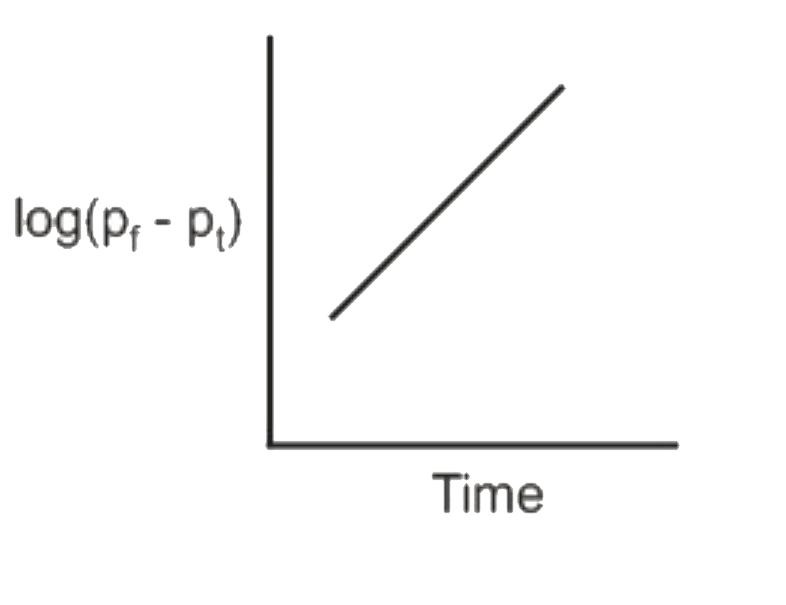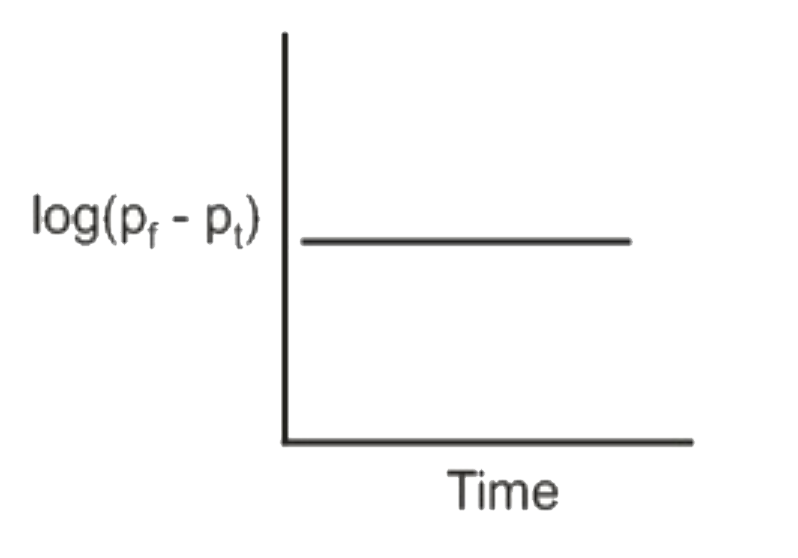Benene diazonium chloride in aqueous solution decomposes as : C6H5−N=N+Cl−aq+H2Oaq→C6H5OHaq+N2(g)+HClaq The reaction follows first order kinetics. If Pt is the pressure of N2 at time t and Pf that after completion of the reaction, at constant volume and temperature, then which of the following graphs conforms to the kinetics of the reaction ?




The correct Answer is:C
To solve the problem regarding the decomposition of benzene diazonium chloride and its kinetics, we will follow these steps:
Step 1: Understand the Reaction
The given reaction is:
C6H5−N=N+(Cl−)+H2O→C6H5OH+N2+HCl
This reaction indicates that benzene diazonium chloride decomposes in the presence of water to produce phenol, nitrogen gas, and hydrochloric acid.
Step 2: Identify the Kinetics
The problem states that this reaction follows first-order kinetics. For a first-order reaction, the rate of reaction is directly proportional to the concentration of the reactant.
Step 3: Write the Integrated Rate Law
The integrated rate law for a first-order reaction can be expressed as:
k=2.303tlog(aa−x)
Where:
- k is the rate constant,
- t is the time,
- a is the initial concentration,
- x is the amount reacted.
Step 4: Relate Pressure to Concentration
In this case, we can relate the pressure of nitrogen gas produced to the concentration of the reactant. Let:
- Pt be the pressure of nitrogen at time t,
- Pf be the pressure of nitrogen at the completion of the reaction.
The initial pressure Pf corresponds to the initial concentration of benzene diazonium chloride. As the reaction progresses, the pressure Pt increases as nitrogen gas is produced.
Step 5: Substitute into the Rate Law
We can express the concentrations in terms of pressures:
- a is proportional to Pf,
- a−x is proportional to Pf−Pt.
Thus, we can rewrite the integrated rate law:
k=2.303tlog(PfPf−Pt)
Step 6: Rearranging the Equation
Rearranging gives:
log(Pf−Pt)=−k2.303t+logPf
This equation is in the form of y=mx+b, where:
- y=log(Pf−Pt),
- m=−k2.303 (the slope),
- x=t,
- b=logPf (the y-intercept).
Step 7: Graph Interpretation
The graph of log(Pf−Pt) versus time t will be a straight line with a negative slope, indicating that as time increases, the logarithm of the pressure difference decreases.
Conclusion
The correct graph that represents the kinetics of the reaction will show a straight line with a negative slope when plotting log(Pf−Pt) against time t.
The given reaction is:
C6H5−N=N+(Cl−)+H2O→C6H5OH+N2+HCl
The problem states that this reaction follows first-order kinetics. For a first-order reaction, the rate of reaction is directly proportional to the concentration of the reactant.
The integrated rate law for a first-order reaction can be expressed as:
k=2.303tlog(aa−x)
Where:
- k is the rate constant,
- t is the time,
- a is the initial concentration,
- x is the amount reacted.
In this case, we can relate the pressure of nitrogen gas produced to the concentration of the reactant. Let:
- Pt be the pressure of nitrogen at time t,
- Pf be the pressure of nitrogen at the completion of the reaction.
We can express the concentrations in terms of pressures:
- a is proportional to Pf,
- a−x is proportional to Pf−Pt.
k=2.303tlog(PfPf−Pt)
Rearranging gives:
log(Pf−Pt)=−k2.303t+logPf
- y=log(Pf−Pt),
- m=−k2.303 (the slope),
- x=t,
- b=logPf (the y-intercept).
The graph of log(Pf−Pt) versus time t will be a straight line with a negative slope, indicating that as time increases, the logarithm of the pressure difference decreases.
The correct graph that represents the kinetics of the reaction will show a straight line with a negative slope when plotting log(Pf−Pt) against time t.
Similar Questions
Complete the following reaction equations :
(i) C6H5N2Cl+H3PO2+H2O→
(ii)C6H5NH2+Br2(aq.)→
View SolutionDiazonium salt decomposes as
C6H5N⊕2Clɵ→C6H5Cl+N2
at 10∘C, the evolution of N2 becomes two first faster when the initial concentration of the salt is doubled. Thus, it is
View SolutionThe reaction 2N2O5(g)→4NO2(g) is first order w.r.t. N2O5. Which of the following graphs would yield a straight line?
View SolutionCH3COOC2H5(aq)+H2O(l)H+(aq)−−−−−→CH3COOH(aq)+C2H5OH(aq). What type of reaction is this?
View SolutionDecomposition of NH4NO2(aq into N2(g) and 2H2O(l) is first order reaction.
View SolutionIn the resction 2NH+4+6NO−3(aq)+4H+(aq)→6NO2(g)+N2(g)+6H2O the reducing agent is
View SolutionComplete the reaction :
C2H5Cl+KOH(aq)→
View SolutionThe heat liberated in the following reaction
H+(aq)+OH−(aq)→H2O(l) is
View SolutionC6H5N2+Cl−Cu2Cl2/HCl−−−−−−−−−→ , this reaction is named as
View SolutionWrite the equilibrium constant expression for the following reactions :
HCl(aq)+H2O(l)⇔H3O++Cl−(aq)
View Solution
